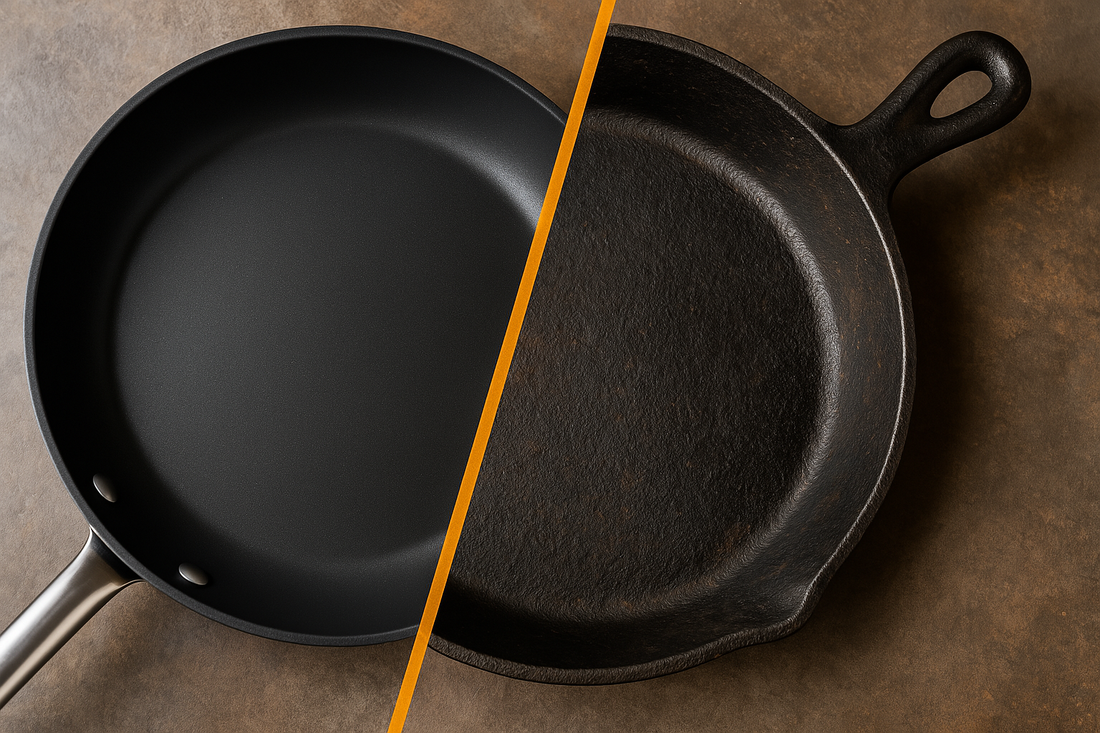
Is Your Non-Stick Pan Harming Your Health?
Share
Let’s be honest — non-stick cookware is convenient. It’s easy to clean, food slides right off, and you barely need oil. But what if we told you that same convenience could come at the cost of your health?
The Hidden Dangers in Your Modern Cookware
Most non-stick pans are coated with chemicals like PTFE (commonly known by the brand name Teflon) and PFOA. When heated above 260°C (500°F), PTFE starts breaking down and releases toxic fumes that can cause flu-like symptoms in humans — a condition literally called “Teflon flu.”¹ And it gets worse: PFOA, once commonly used in non-stick coatings, has been linked to cancer, thyroid disorders, and developmental issues.² Even though it's being phased out, traces can still linger in older cookware.
So, what’s the alternative?
Cookware That Gives Back to Your Food
Traditional Indian cookware — made from metals like brass, bronze, copper, cast iron, and natural materials like soapstone — isn’t just safer. It’s beneficial.
These age-old materials do more than just avoid harm — they actively support your well-being:
-
Brass (Peetal): Known for improving immunity and balancing the three doshas in Ayurveda. Cooking or storing food in brass can increase strength and sharpen the mind.³
-
Bronze (Kansa): This alloy of copper and tin is believed to improve digestion and sharpen memory. Studies suggest bronze vessels can reduce acidity and help maintain gut health.⁴
-
Copper (Tamba): An ancient antimicrobial. In fact, modern hospitals use copper surfaces to reduce the spread of infections.⁵ When used properly (with acidic foods avoided), copper can support cardiovascular health and brain function.⁶
-
Soapstone (Kalchatti): This natural stone retains heat beautifully and slowly releases essential minerals like calcium and magnesium into food, especially during long simmering.⁷
-
Cast Iron: Perhaps the most underrated of the lot. Cooking in cast iron can naturally increase the iron content of food, which is crucial for fighting anemia — a condition affecting more than 50% of Indian women.⁸ Studies show that even short-term cooking in cast iron can significantly boost iron levels in common dishes like curry and rice.⁹
But Wait — Why Did We Ever Stop Using These?
One word: convenience. Metal and stone cookware needs care — seasoning, drying, no dishwashers. But with that extra effort comes a priceless return: fewer toxins, more minerals, and a connection to tradition and health that non-stick pots just can’t offer.
A Shocking Reality: Cooking Can Heal (Or Harm)
What’s truly surprising is how powerful your cookware really is. We think of food as the main factor in our health — but what we cook it in matters just as much. Your daily dal simmering in a soapstone pot, or your curry bubbling in a cast iron kadhai, might be giving you a daily dose of iron or minerals your body actually needs. Try saying that about a synthetic pan from the supermarket!
Citations:
1. Environmental Working Group. "Canaries in the Kitchen: Teflon Toxicity in Birds and Humans." (2003)
2. C8 Science Panel. “Probable Link Reports.” (2005–2013)
3. Sharma, P. V. Dravyaguna Vijnana (Materia Medica – Vegetable). (1986)
4. Pandey, A. et al. “Impact of Bronze Cookware on Food and Health.” Journal of Ethnopharmacology, (2018)
5. Grass, G. et al. “Metallic copper as an antimicrobial surface.” Applied and Environmental Microbiology (2011)
6. Institute of Medicine. “Dietary Reference Intakes for Copper.” (2001)
7. Indian Institute of Technology, Madras. “Mineral Leaching from Traditional Cookware.” (2015)
8. National Family Health Survey (NFHS-5), Ministry of Health and Family Welfare, India (2019–21)
9. Adish, A. A., et al. “Effect of iron cooking pots on iron content of food and haemoglobin level of young children.” The Lancet, (1999)
